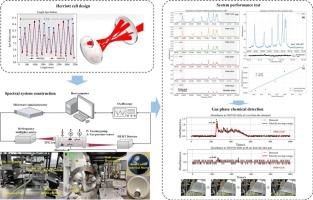Development of a Herriott multi-pass cell for gas phase terahertz spectroscopy
IF 3.4
3区 物理与天体物理
Q2 INSTRUMENTS & INSTRUMENTATION
引用次数: 0
Abstract
Terahertz spectroscopy has emerged as an important technique for gas detection, however, its sensitivity in detecting specific gases remains inadequate, limiting its wider application. To address this issue, this paper presents a design methodology for a Herriott cell specifically optimised for the low THz frequency range. By using multiple reflections for focusing, this method overcomes the problem of large divergence angles of THz beams, effectively suppresses beam distortion, and maximises the optical path length, thereby significantly improving the detection sensitivity for trace gases. Based on this design, a Herriott cell suitable for the 260–400 GHz frequency range has been developed. A Herriott cell with a 3.3 m optical path was fabricated and a THz gas spectroscopy test system based on this cell was established. Experimental results show that the local noise of the THz spectra for pure trace gases is in the order of 10-3, while the noise for the acetonitrile −air mixture is in the order of 10-2. The system is capable of detecting pure acetonitrile and methanol gases at pressures below 0.0119 Pa and 0.0269 Pa, respectively, as well as acetonitrile at a partial pressure of 0.00935 in a 10 Pa acetonitrile/air mixture.

气相太赫兹光谱Herriott多通池的研制
太赫兹光谱技术已成为一种重要的气体检测技术,但其检测特定气体的灵敏度仍然不足,限制了其广泛应用。为了解决这个问题,本文提出了一种专为低太赫兹频率范围优化的赫里奥特电池的设计方法。该方法利用多次反射进行聚焦,克服了太赫兹光束发散角大的问题,有效地抑制了光束畸变,使光程长度最大化,从而显著提高了对痕量气体的探测灵敏度。在此基础上,研制了一种适用于260 ~ 400 GHz频段的Herriott小区。制作了光程为3.3 m的Herriott电池,并在此基础上建立了太赫兹气体光谱测试系统。实验结果表明,纯微量气体太赫兹光谱的局部噪声为10-3级,而乙腈-空气混合物的噪声为10-2级。该系统能够检测压力分别低于0.0119 Pa和0.0269 Pa的纯乙腈和甲醇气体,以及分压为0.00935的乙腈/空气混合物中10 Pa的乙腈。
本文章由计算机程序翻译,如有差异,请以英文原文为准。
求助全文
约1分钟内获得全文
求助全文
来源期刊
CiteScore
5.70
自引率
12.10%
发文量
400
审稿时长
67 days
期刊介绍:
The Journal covers the entire field of infrared physics and technology: theory, experiment, application, devices and instrumentation. Infrared'' is defined as covering the near, mid and far infrared (terahertz) regions from 0.75um (750nm) to 1mm (300GHz.) Submissions in the 300GHz to 100GHz region may be accepted at the editors discretion if their content is relevant to shorter wavelengths. Submissions must be primarily concerned with and directly relevant to this spectral region.
Its core topics can be summarized as the generation, propagation and detection, of infrared radiation; the associated optics, materials and devices; and its use in all fields of science, industry, engineering and medicine.
Infrared techniques occur in many different fields, notably spectroscopy and interferometry; material characterization and processing; atmospheric physics, astronomy and space research. Scientific aspects include lasers, quantum optics, quantum electronics, image processing and semiconductor physics. Some important applications are medical diagnostics and treatment, industrial inspection and environmental monitoring.

 求助内容:
求助内容: 应助结果提醒方式:
应助结果提醒方式:


